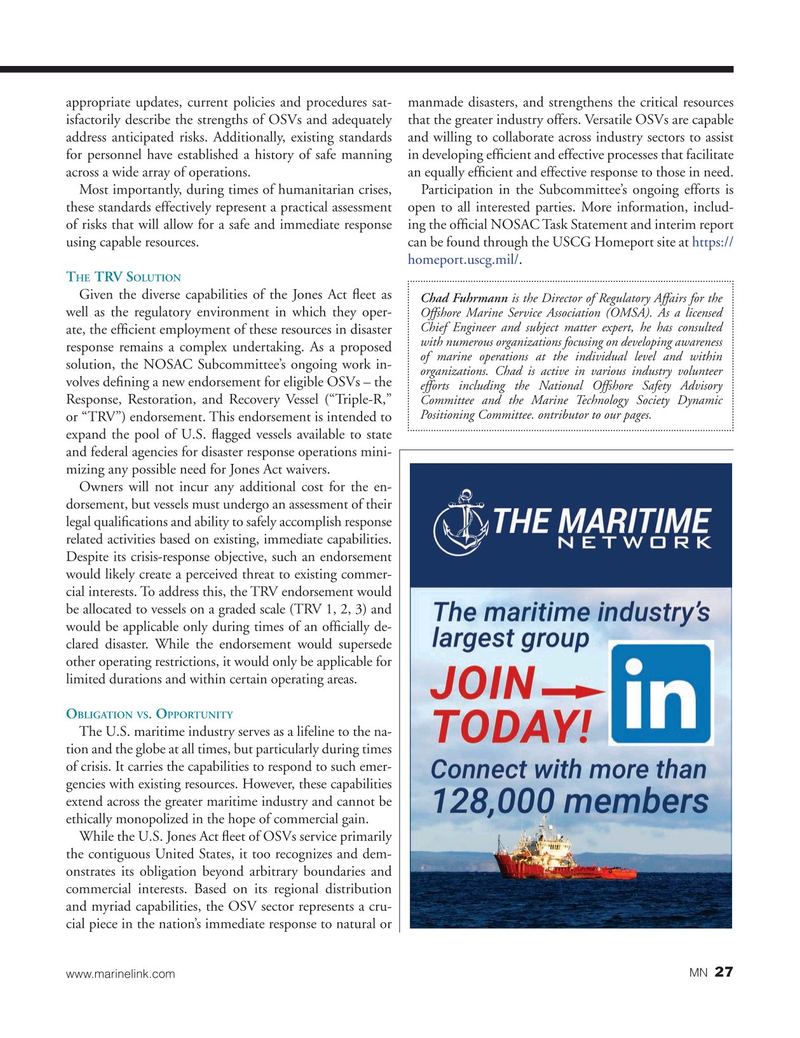
Page 27: of Marine News Magazine (July 2019)
Propulsion Technology
Read this page in Pdf, Flash or Html5 edition of July 2019 Marine News Magazine
appropriate updates, current policies and procedures sat- manmade disasters, and strengthens the critical resources isfactorily describe the strengths of OSVs and adequately that the greater industry offers. Versatile OSVs are capable address anticipated risks. Additionally, existing standards and willing to collaborate across industry sectors to assist for personnel have established a history of safe manning in developing ef? cient and effective processes that facilitate across a wide array of operations. an equally ef? cient and effective response to those in need.
Most importantly, during times of humanitarian crises, Participation in the Subcommittee’s ongoing efforts is these standards effectively represent a practical assessment open to all interested parties. More information, includ- of risks that will allow for a safe and immediate response ing the of? cial NOSAC Task Statement and interim report using capable resources. can be found through the USCG Homeport site at https:// homeport.uscg.mil/.
HE OLUTION
T TRV S
Given the diverse capabilities of the Jones Act ? eet as
Chad Fuhrmann is the Director of Regulatory Affairs for the well as the regulatory environment in which they oper-
Offshore Marine Service Association (OMSA). As a licensed
Chief Engineer and subject matter expert, he has consulted ate, the ef? cient employment of these resources in disaster with numerous organizations focusing on developing awareness response remains a complex undertaking. As a proposed of marine operations at the individual level and within solution, the NOSAC Subcommittee’s ongoing work in- organizations. Chad is active in various industry volunteer volves de? ning a new endorsement for eligible OSVs – the efforts including the National Offshore Safety Advisory
Response, Restoration, and Recovery Vessel (“Triple-R,”
Committee and the Marine Technology Society Dynamic
Positioning Committee. ontributor to our pages.
or “TRV”) endorsement. This endorsement is intended to expand the pool of U.S. ? agged vessels available to state and federal agencies for disaster response operations mini- mizing any possible need for Jones Act waivers.
Owners will not incur any additional cost for the en- dorsement, but vessels must undergo an assessment of their legal quali? cations and ability to safely accomplish response related activities based on existing, immediate capabilities.
Despite its crisis-response objective, such an endorsement would likely create a perceived threat to existing commer- cial interests. To address this, the TRV endorsement would be allocated to vessels on a graded scale (TRV 1, 2, 3) and would be applicable only during times of an of? cially de- clared disaster. While the endorsement would supersede other operating restrictions, it would only be applicable for limited durations and within certain operating areas.
O . O
BLIGATION VS PPORTUNITY
The U.S. maritime industry serves as a lifeline to the na- tion and the globe at all times, but particularly during times of crisis. It carries the capabilities to respond to such emer- gencies with existing resources. However, these capabilities extend across the greater maritime industry and cannot be ethically monopolized in the hope of commercial gain.
While the U.S. Jones Act ? eet of OSVs service primarily the contiguous United States, it too recognizes and dem- onstrates its obligation beyond arbitrary boundaries and commercial interests. Based on its regional distribution and myriad capabilities, the OSV sector represents a cru- cial piece in the nation’s immediate response to natural or 27
MN www.marinelink.com
MN July19 Layout 18-31.indd 27 6/20/2019 9:44:49 AM

 26
26

 28
28
